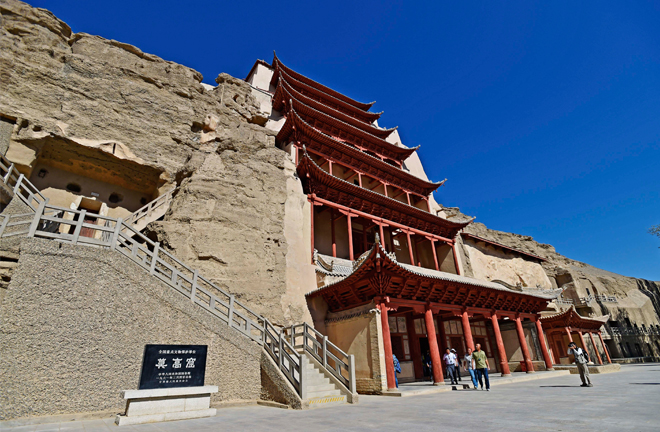Modern measures taken to preserve grottoes

With unique natural and geographical conditions, Gansu Province was a major witness to the prosperity of the ancient Silk Road. Photo: Lin Lin provided to CSST
An international forum on integration and innovation in traditional Chinese sculpture was held in Tianshui, Gansu Province, and attended by more than 100 scholars from home and abroad.
“With unique natural and geographical conditions, Gansu Province was a major witness to the prosperity of the ancient Silk Road. The abundant grottoes in the region showcase the integration of Silk Road culture,” said Wang Xudong, director of the Institute of Dunhuang Studies. In 2016, the institute began to manage the province’s representative grottoes scattered in Dunhuang, Guazhou, Tianshui and Qingyang.
“Over the past 74 years, people engaged in Mogao Caves protection have strived to eradicate or alleviate the natural and human threats to the caves, so that the heritage could be preserved for a long time,” Wang said. Supporting grotto protection, the institute worked to promote this cultural heritage across the world. The goal is supported by systematic management and diverse professionals. Academic studies are central to the goal while innovation and strategies play a crucial role. Talented people with multi-disciplinary backgrounds work together, so that the valuable cultural heritage will contribute to today’s social and cultural integration.
“Protection, study and promotion need to be developed in a balanced way. Comprehensive protection helps to preserve cultural heritage by adopting appropriate technology and management,” Wang said. He introduced how Mogao Caves uses technology and management to protect relics, including a risk-control based warning system, a rigid evaluation mechanism, delicate protection technologies and complete operating procedures.
At present, cultural relics focus on preventive protection, in which digitization is a crucial method. The research and development of new technologies will address inefficient protection and make cultural heritage more sustainable.
At Mogao Caves, the collaborative management has taken relevant measures to emphasize the caves’ resources and social value. The institute has built a free academic atmosphere and opened research resources to the public. Also, it has set up an international platform to promote multidisciplinary studies at various levels.
Mogao Caves received a total of 200,000 visitors in 1979, and the number surged to more than 1.6 million in 2017. The increase in visitors has posed challenges for management and use. Now the tourist destination is working to satisfy the demands of different groups through online exhibitions, emergency visits, a digital resource database, multi-lingual displays and cultural products, thereby promoting the culture embedded in Mogao Caves.
This article was translated from Guangming Daily.
(edited by MA YUHONG)
